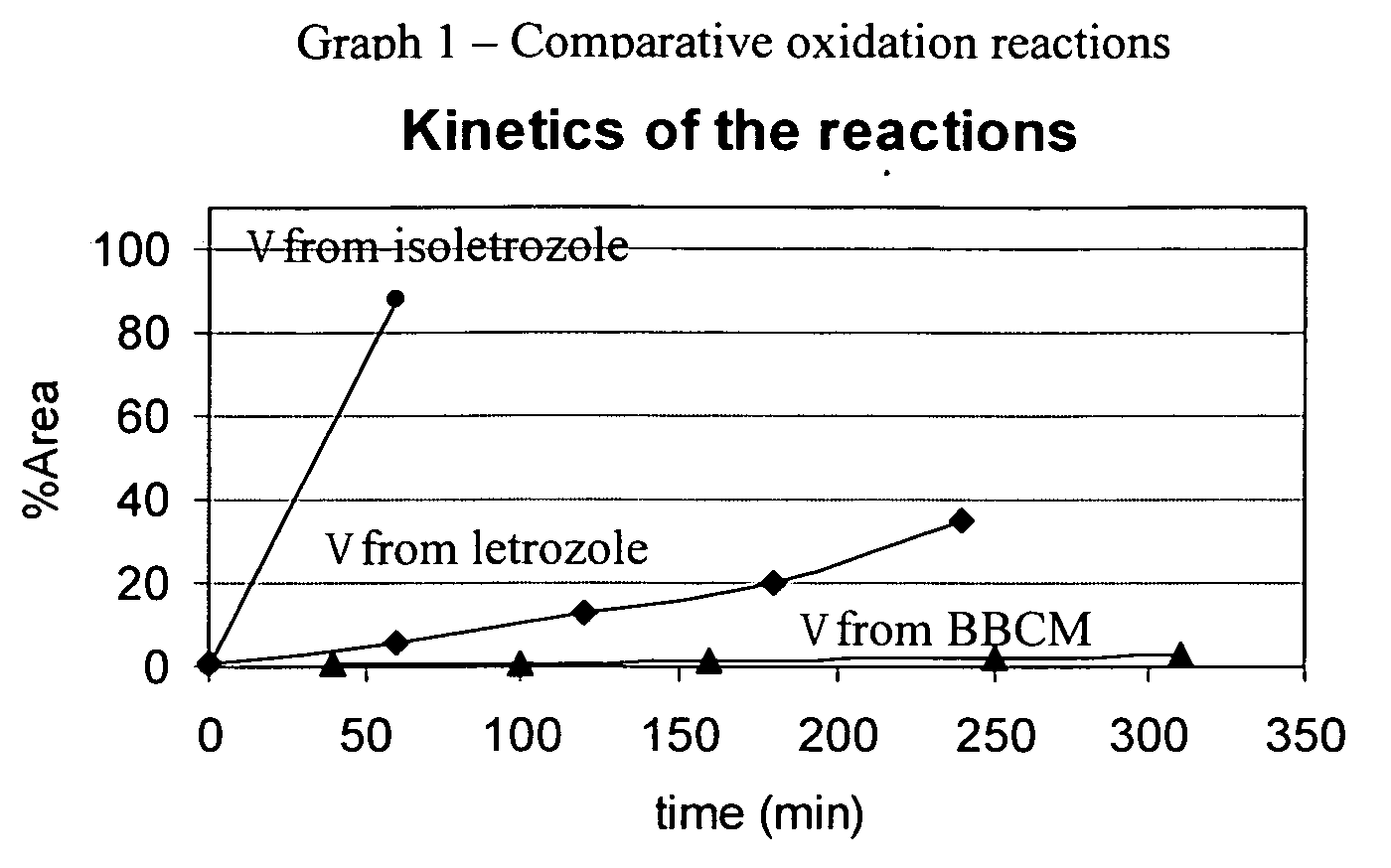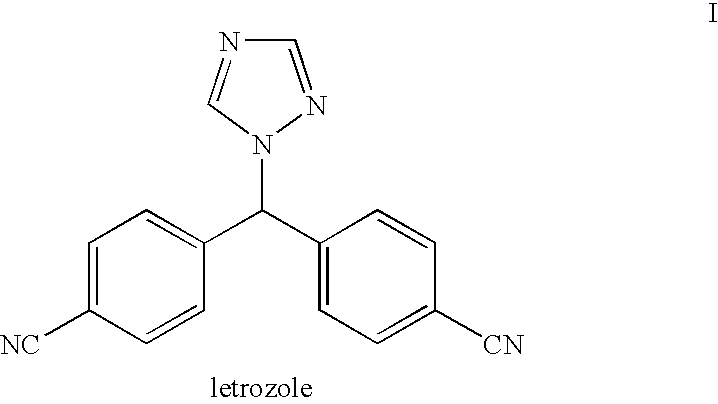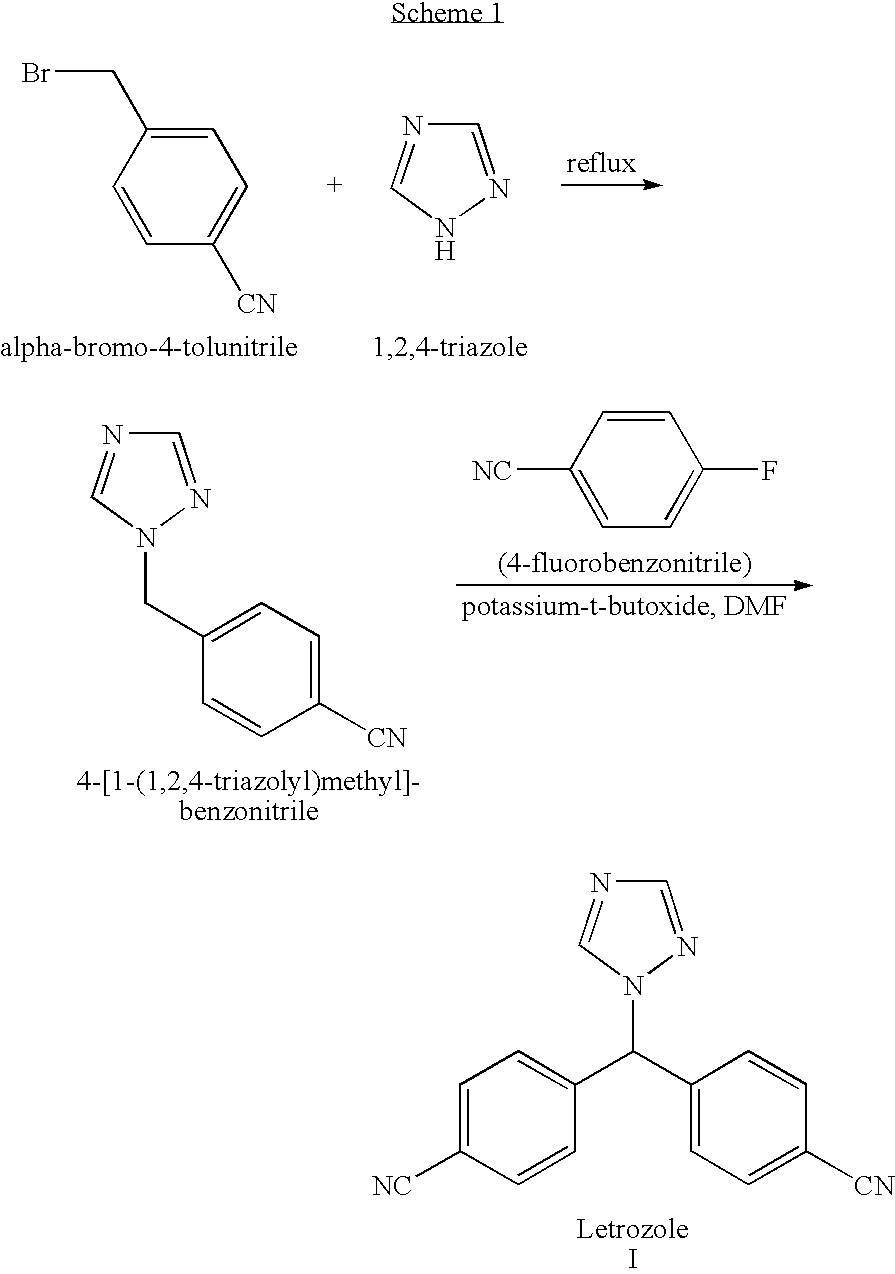Letrozole purification process
a technology of purification process and letrozole, which is applied in the direction of biocide, heterocyclic compound active ingredients, drug compositions, etc., can solve the problems of reducing estrogen production, significantly lowering serum estrogens, and impractical industrial scale, and achieves easy separability
- Summary
- Abstract
- Description
- Claims
- Application Information
AI Technical Summary
Benefits of technology
Problems solved by technology
Method used
Image
Examples
reference example 1
[0047] A reactor was charged with triazole (104 g, 1.5 moles) and bromo-bis(4-cyanophenyl)methane (108 g, 0.6 mole) followed by addition of DMF (720 ml) and toluene (1080 ml), and the impeller speed was set at 800 RPM. The temperature was raised to 60° C. and potassium carbonate was added (83.5 g, 0.6 mole). Then, the temperature was raised to 80° C. and mixing was maintained at this temperature during about 1.5 hours. An aliquot was withdrawn from the reaction mixture, diluted with a mixture of water and acetonitrile and analyzed by HPLC. The letrozole content was 83%, the isoletrozole content was 11.4%, while the content of 4,4′-dicyanobenzophenone was 1.6%. After cooling to a temperature of 25° C., acetic acid (57.6 ml) was added. DMF (414 ml) and water (1760 ml) were added to the reaction mixture to form a suspension (two liquid phases and a solid inter-phase in between). After heating the suspension to 60° C. the resulting mixture was allowed to cool to 25° C. for one hour and ...
example 2
[0048] A reactor was charged with triazole (104 g, 1.5 moles) and bromo-bis(4-cyanophenyl)methane (108 g, 0.6 mole) followed by addition of DMF (720 ml) and toluene (1080 ml), and the impeller speed was set at 800 RPM. The temperature was raised to 60° C. and potassium carbonate was added (83.5 g, 0.6 mole). Then, the temperature was raised to 80° C. and mixing was maintained at this temperature during about 1.5 hours. Then, air was bubbled at the same temperature for about 15 minutes at 3500 ml / minute air flow. An aliquot was withdrawn from the reaction mixture, diluted with a mixture of water and acetonitrile and injected to HPLC. The letrozole content was 73%, the isoletrozole content was 8.7% and of 4,4′-dicyano-benzophenone was 16.2%. After cooling to a temperature of 25° C., acetic acid (57.6 ml) was added. DMF (414 ml) and water (1760 ml) were added to the reaction mixture to form a suspension (two liquid phases and a solid inter-phase in between). After heating the suspensio...
examples 3-7
[0049] Letrozole was prepared according to Example 2, while the selective oxidation of isoletrozole was carried out at different reaction conditions. The results are detailed in tables 1 and 2 below, wherein table 1 specifies the experimental parameters and table 2 summarizes the results of the experiments.
TABLE 1Experimental parametersExperimentImpellerReactionAir(Example)speed,Impellertemp.ReactionbubblingNo.RPMconfiguration° C.time (hrs)time, min3600pump down70° C.10.0304700pump up80° C.2.0305800″80° C.2.516800″70° C.2.5157700″80° C.1.510
[0050]
TABLE 2Analytical ResultsExperiment(Example)IsoletrozoleIsoletrozoleContent ofIsoletrozoleNocontent %*letrozole, %**content %**V, %**content %***315.377.511.813.32.2414.5503.935.60.8516.780.816.01.71.8614.180.211.911.32.2714.07310.017.21.1
*End of the reaction without air bubbling
**End of the reaction with air bubbling
***After precipitating isoletrozole from the reaction mixture of the reaction including air bubbling
V = 4,4′-dicyanobenz...
PUM
| Property | Measurement | Unit |
|---|---|---|
| temperature | aaaaa | aaaaa |
| temperature | aaaaa | aaaaa |
| temperature | aaaaa | aaaaa |
Abstract
Description
Claims
Application Information
 Login to View More
Login to View More - R&D
- Intellectual Property
- Life Sciences
- Materials
- Tech Scout
- Unparalleled Data Quality
- Higher Quality Content
- 60% Fewer Hallucinations
Browse by: Latest US Patents, China's latest patents, Technical Efficacy Thesaurus, Application Domain, Technology Topic, Popular Technical Reports.
© 2025 PatSnap. All rights reserved.Legal|Privacy policy|Modern Slavery Act Transparency Statement|Sitemap|About US| Contact US: help@patsnap.com



